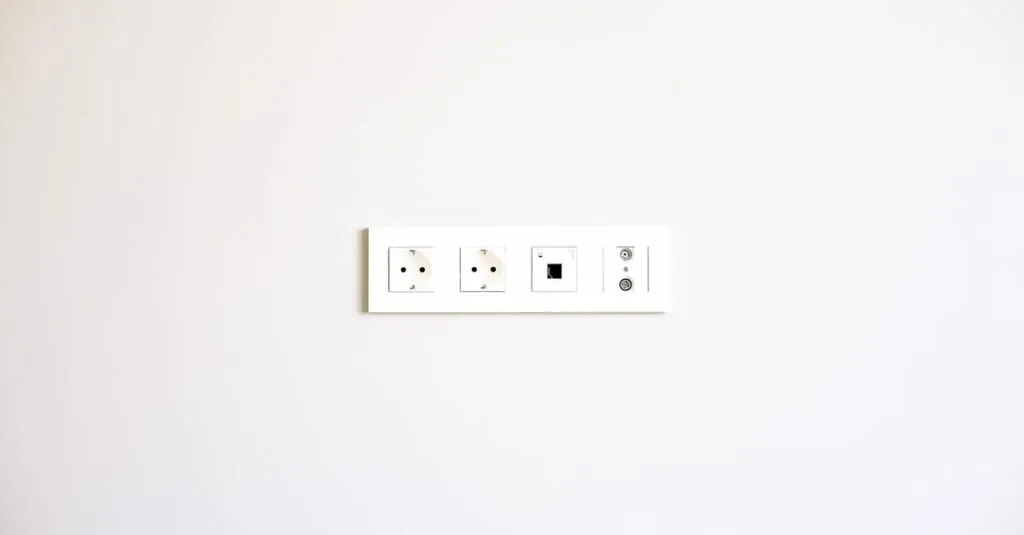Table of Contents
ToggleImagine waking up in a world where your coffee brews itself, your lights know when to dim, and your thermostat adjusts without you lifting a finger. Welcome to the magic of smart home electrical installation! It’s not just a trend; it’s the future of living, where technology meets convenience in the most delightful way.
But before you dive headfirst into the realm of smart gadgets, there’s a crucial step: the installation. This isn’t just about plugging in a few devices and calling it a day. It requires expertise to ensure everything works seamlessly and safely. After all, nobody wants their toaster communicating with their vacuum cleaner in a chaotic dance-off! So let’s explore how to transform your home into a smart haven while keeping things safe, efficient, and maybe even a little humorous along the way.
Overview Of Smart Home Electrical Installation
Smart home electrical installation involves integrating advanced technologies into residential settings for enhanced functionality and user convenience. Automation systems facilitate control over lighting, temperature, and security features through mobile devices or voice commands. Effective installation plays a key role in ensuring these systems operate safely and efficiently.
Understanding the requirements for smart devices is crucial. Different devices may require specific electrical configurations and could vary based on voltage and connectivity options. Technicians must evaluate electrical systems to ensure compatibility with smart technologies.
Industries are increasingly recognizing the importance of energy efficiency. Smart devices often include features that monitor and optimize energy usage. These features not only contribute to lower utility bills but also promote sustainable living practices in homes.
Safety and compliance with codes govern the installation process. Local electrical codes specify installation procedures to prevent potential hazards and ensure device reliability. Employing licensed professionals guarantees adherence to these regulations, reducing risks associated with improper installations.
Many homeowners benefit from consulting with experts during the planning phase. Assessing the home’s existing electrical layout can enhance the design and functionality of smart systems. Specialists can provide insights on the best equipment choices and optimal placement for devices.
Various technologies, such as Wi-Fi, Zigbee, and Z-Wave, support smart home networks. Choosing the right technology influences how devices communicate and integrate with each other. Each option offers unique advantages and limitations, shaping user experiences.
Tailoring installations to fit specific needs creates a personalized smart home experience. Homeowners can prioritize elements like security, convenience, or energy management based on their lifestyles. This level of customization enhances satisfaction and improves daily living.
By understanding smart home electrical installation, homeowners can transform their living spaces into more connected and efficient environments.
Benefits Of Smart Home Electrical Installation
Smart home electrical installations offer various advantages that improve daily life. These benefits include enhanced convenience and improved energy efficiency.
Enhanced Convenience
Smart home installations simplify everyday tasks. Homeowners control various systems, like lighting and security, from a single mobile app or with voice commands. Smart lighting adjusts based on occupancy or time of day, providing optimal brightness effortlessly. Programmable thermostats allow automatic temperature adjustments for comfort or energy savings. Integration with smart speakers enables easy access to device control, promoting a seamless user experience. Features like remote access let users monitor homes while away, enhancing security and peace of mind. Automation routines add further convenience, ensuring lights turn off or on at specified times.
Improved Energy Efficiency
Energy efficiency ranks high among smart home installation benefits. Smart devices contribute to lower utility bills through energy monitoring and optimization. These systems track energy consumption, providing real-time feedback and identifying usage patterns. Homeowners can adjust settings to maximize efficiency, reducing energy waste. For instance, smart thermostats learn user preferences and adjust heating or cooling accordingly. Smart plugs cut power to devices when not in use, preventing phantom energy consumption. Integrating solar panels with smart systems enhances sustainability while decreasing reliance on traditional energy sources. By promoting responsible energy use, smart installations contribute to a greener lifestyle.
Essential Components Of Smart Home Electrical Systems
Smart home electrical systems rely on various advanced components for efficiency and functionality. Understanding these essential parts enhances overall user experience.
Smart Lighting Solutions
Smart lighting offers adaptability and energy efficiency for homeowners. Control systems through mobile devices or voice commands allow for seamless management of lighting levels. Use of smart bulbs, switches, and sensors creates personalized lighting experiences tailored to individual preferences. Scheduling and automation features help optimize light usage, adapting to daily routines and reducing energy consumption. Integration with other smart devices, such as motion detectors and timers, enhances safety and convenience. Efficient LED options extend bulb life and minimize energy costs, making smart lighting a valuable addition to any home.
Smart Thermostats
Smart thermostats provide advanced temperature control for improved comfort and energy savings. These devices learn user habits and automatically adjust heating or cooling based on preferences. Remote access via smartphone apps allows users to monitor and modify settings while away from home. Scheduling functions enable precise control, optimizing energy use throughout the day. Most smart thermostats track energy usage, offering insights on consumption patterns. This feedback empowers users to make informed decisions, further enhancing efficiency. By connecting with other smart home systems, thermostats contribute to a cohesive and intelligent energy management solution.
Installation Process For Smart Home Electrical Systems
The installation process for smart home electrical systems requires careful attention to detail. Proper planning ensures that all components work harmoniously.
Planning And Design
Begin by assessing the unique needs of the home. Consider the layout and identify which areas will benefit from smart technology. Prioritizing energy efficiency can enhance functionality, so homeowners should explore options that monitor and optimize energy usage. Integrating various devices like smart lighting and thermostats should align with user habits. Engaging with design experts can clarify the best arrangement of devices, ensuring easy access and seamless control. Detailed planning sets the foundation for effective installation.
Selecting The Right Professional
Choose a licensed electrician with experience in smart home systems. Verify credentials and previous project success to ensure competence. Understanding local electrical codes provides regulatory compliance, reducing risks during installation. Professionals can recommend suitable technologies and products, enhancing the effectiveness of smart devices. Homeowners should communicate their goals clearly to facilitate tailored solutions. Investing in skilled professionals guarantees reliable and safe installations, ultimately improving system performance.
Common Challenges And Solutions
Smart home electrical installation can present several challenges. One common issue involves compatibility among different devices. Ensuring devices work seamlessly together often requires choosing compatible brands or protocols, such as Wi-Fi, Zigbee, or Z-Wave.
Another challenge arises from complex wiring requirements. Understanding electrical codes and safety standards is crucial, as improper wiring can lead to safety hazards. Consulting with licensed electricians ensures adherence to regulations and reduces risks.
Homeowners frequently face difficulties with device placement. Strategically locating smart devices enhances performance and functionality, but requires careful planning of network coverage. Assessing the home layout helps determine optimal locations for devices to maintain strong connections.
Energy consumption monitoring is another area where users encounter challenges. Some homeowners struggle to interpret data provided by smart devices. Utilizing user-friendly apps can simplify energy management and provide clear insights into usage patterns.
Installation time may also become an obstacle. While some devices offer plug-and-play features, others require professional assistance for optimal setup. Hiring experienced electricians can minimize installation time and improve overall system performance.
Connectivity issues may hinder user experience. Inconsistent connections can frustrate users and impair device communication. To address this, ensuring a robust home Wi-Fi network and strategically placing Wi-Fi extenders or hubs can strengthen connections.
User interfaces sometimes create confusion for individuals unfamiliar with smart technology. A steep learning curve can deter some homeowners from fully utilizing their systems. Choosing devices with intuitive interfaces and comprehensive support resources eases this challenge.
Keeping up with regular software updates is essential. Failure to update devices can lead to security vulnerabilities and decreased functionality. Scheduling automatic updates helps maintain device performance and security over time.
Smart home electrical installation opens the door to a more efficient and convenient living experience. By integrating advanced technologies homeowners can enjoy seamless control over various systems while promoting energy efficiency.
Working with licensed professionals ensures safety and compliance with local codes while addressing unique needs. With careful planning and the right equipment homeowners can create a personalized smart environment that enhances daily life.
Embracing smart home technology not only simplifies everyday tasks but also contributes to a sustainable lifestyle. As technology continues to evolve staying informed about the latest advancements will help homeowners make the most of their smart installations.







